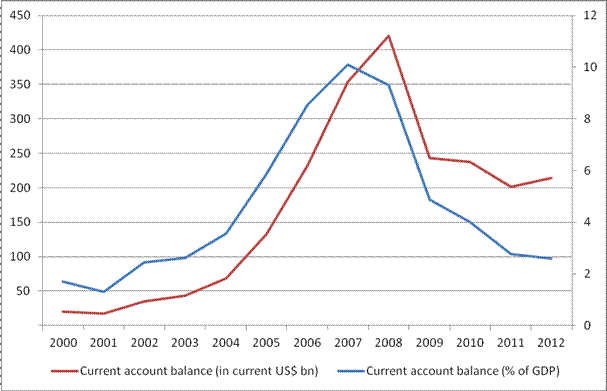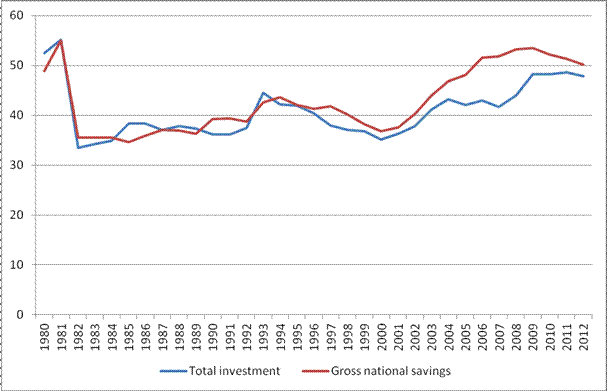Today we are fortunate to have a guest contribution written Hiro Ito (Portland State U.) and Ulrich Volz (U. London SOAS and DIE). This article is based Ito and Volz (RIE, 2013).
It has been long argued that correcting microeconomic distortions in countries with persistent current account imbalances is a central precondition for global macroeconomic rebalancing. For China, a country with a persistent current account surplus, it has been frequently claimed that the surplus derives from microeconomic or sectorial distortions that have led to excessive saving (e.g., Lardy, 2012). In particular, underdeveloped public social safety net systems as well as a repressed financial sector are commonly blamed for excessive saving.
Although China’s current account surplus, which was a remarkable 10.1% of GDP in 2007, has come down to 2.6% in 2012 (Figure 1), the narrowing of imbalances appears to be rather cyclical than structural; it seems to be driven by a decline in external demand and a boost of public investment rather than by changes to the country’s perennial development model. As a response to the outbreak of the Global Financial Crisis, the Chinese government launched a huge stimulus program amounting to RMB 4 trillion (US$ 586 billion) in November 2008. Further fiscal and monetary stimulus followed in response to the anemic international demand due to the Great Recession in the U.S. and the debt crisis in Europe. As a consequence, China’s fixed investment rate increased from 41.7% of GDP in 2007 to about 48% in 2012, while the savings rate remained above 50% of GDP throughout (Figure 2), thereby shrinking the current account surplus.

Figure 1: China’s current account balance in bn US$ (left axis) and as % of GDP (right axis). Source: Compiled by authors with data from IMF IFS and SAFE.

Figure 2: Investment and saving (as % of GDP). Source: Compiled by authors with data from IMF WEO October 2012
Note: Data for 2012 are estimates.
How Chinese saving and investment rates will develop in the coming years is a question of crucial importance not just for China, but for the entire world economy. In a recent article (Ito and Volz, 2013), we analyzed how reforms in the financial sector, social protection, and healthcare programs affect China’s saving and investment rates and also its current account. To this end, we conducted panel data analysis using a comprehensive dataset that covers 83 countries during the last two decades. Using cross-country characteristics found in the analysis, we then attempted to unravel China’s peculiarities and shed light on its prominent role in the global imbalances debate. We also extended the cross-country analysis to provide forecasting on how China’s sectorial reforms will affect the country’s current account imbalances.
Our cross-country estimation results indicate that domestic financial reforms affect both national saving and investment, and thereby the current account balance. In particular, our estimations confirm the oft-expressed view that financial repression contributes to higher levels of national saving, or conversely that domestic financial reform would help reduce national savings rates. Furthermore, domestic financial reform is found to lead to lower levels of investment, presumably by curtailing overinvestment resulting from directed lending or other forms of distortive actions by the government.
While we find that increasing social protection expenditure increases national saving for industrialized countries, it apparently reduces national saving for developing and emerging economies. Increases in public social security spending have a negative effect on investment, which may be due to shifts of resources from traditional, more manufacturing-oriented, investment-intensive sectors to more service-oriented and less investment-intensive sectors, such as senior care and healthcare.
Our analysis also shows that reforms related to the financial sector, social safety and healthcare do matter for Chinese saving and investment, and therefore for the current account as well. We make several interesting observations pertaining to China. First, we find that the contribution of domestic financial reform to current account rebalancing has been gradually, but steadily, increasing over the years. Second, although its contribution was not as big as that of domestic financial reform, we find that capital account liberalization also contributed to a lowering of China’s current account surplus. Last but not least, we find that healthcare expenditure was another persistent negative contributor to the Chinese current account.
Based on these results, we conduct scenario analysis to examine the potential impact of various hypothetical reform (and non-reform) scenarios on China’s current account, national saving, and investment. Our predictions suggest that domestic financial liberalization would indeed contribute to a rebalancing of China’s current account surplus. The impact of capital account liberalization on the current account balance, national saving and investment would be minimal, in contrast.
Furthermore, our simulations suggest that China’s current account surplus would decline significantly if the country increased its public healthcare expenditure to a level comparable to that of Brazil, another major emerging economy. This effect would mainly result from a fall in the level of national savings. A strengthening of social protection systems would also contribute to a rebalancing of the Chinese economy.
Overall, our analysis highlights the importance of microeconomic reforms to correct macroeconomic imbalances. In particular, it provides support for the argument that a reform of China’s banking sector, preferably with interest rate liberalization at the centre of such reforms, as well as a development of China’s social security, healthcare and pension system would help the country to reduce its national saving and investment and allow domestic consumption to rise, all of which would help the country to correct its macroeconomic imbalances and get on a path of sustainable and equitable development.
References
Ito, Hiro and Ulrich Volz (2013) China and Global Imbalances from a View of Sectorial Reforms, Review of International Economics, 21(1), 57–71. [link]
Lardy, Nicholas R. 2012. Sustaining China’s Economic Growth after the Global Financial Crisis, Washington, DC: Peterson Institute for International Economics. [link]
This post written by Hiro Ito and Ulrich Volz.
Drawing on past experience and not typifying China per se, the financial cybernetic is a mixed flows of private investment and public initiatives and capital. Some opaque accounting of the private non listed investment recorded in the financial sector and balance sheets. An intricate cascade of money relationships between the cities, the municipalities reverberating on the private projects. It will not be unfamiliar scene to end up negotiating the repayments cash flows of the private project with the city mayor.
In summary China will be better off whilst it can, when addressing very thoroughly the solvability of its financial sector as an utmost priority.
The comment about healthcare spending resonates; I’ve read that a substantial portion of Chinese household savings is driven by fear of medical cost. Correct?
So what happens to China’s thriftiness when demographics kick in and there aren’t enough workers to support retirees? Will today’s savers become tomorrow’s dissavers?
Michael Pettis has been talking about this for years. If you want to understand what’s happening in China, http://www.mpettis.com/
@ppcm I would say the paramount reason that China has a 50% saving rate was the high real estate price/income ratio. Traditionally young Chinese people are forced to own a apartment rather than renting one when they get married, that makes them feel safer. The majority of savings in both their parent’s and their own bank accounts are for this sort of spending.